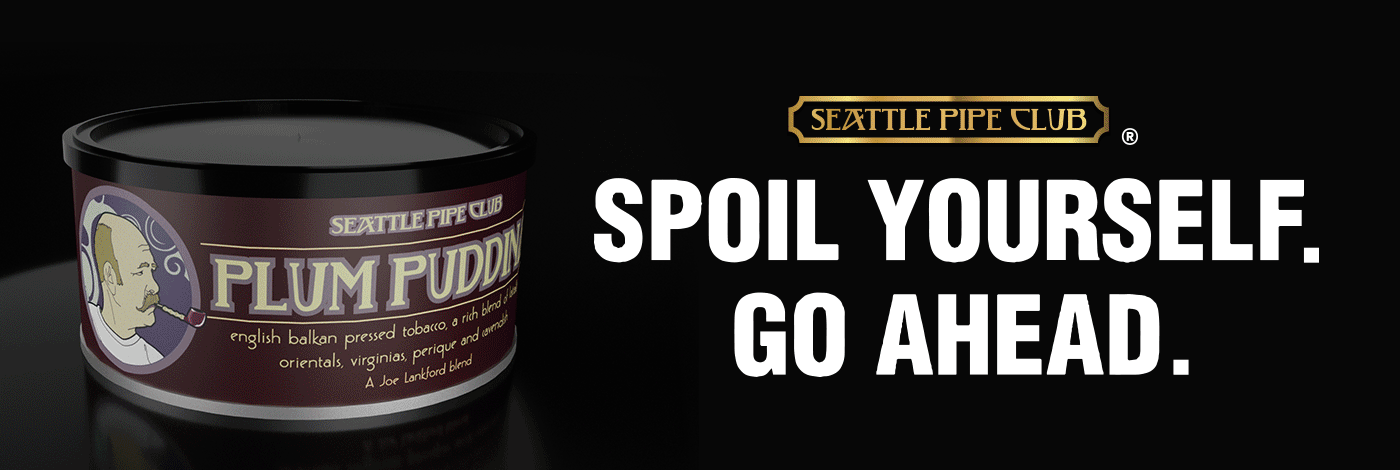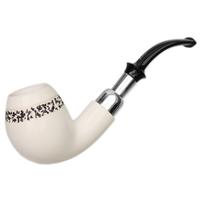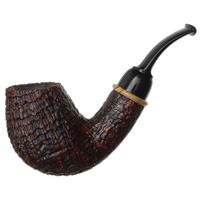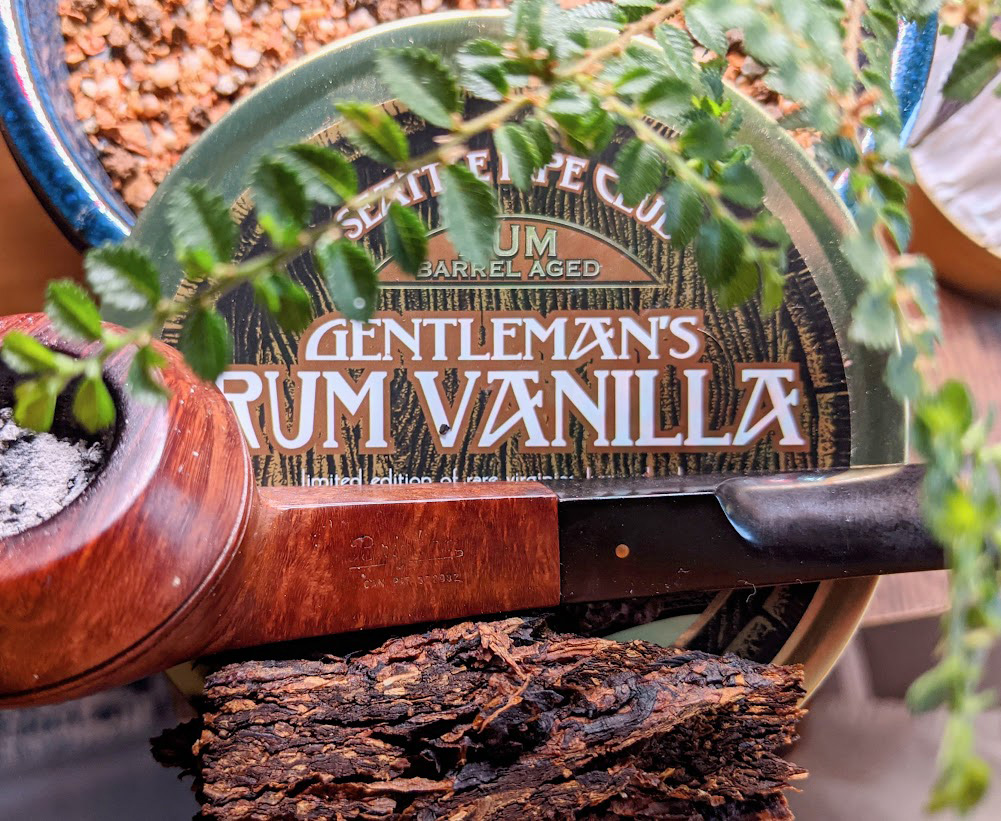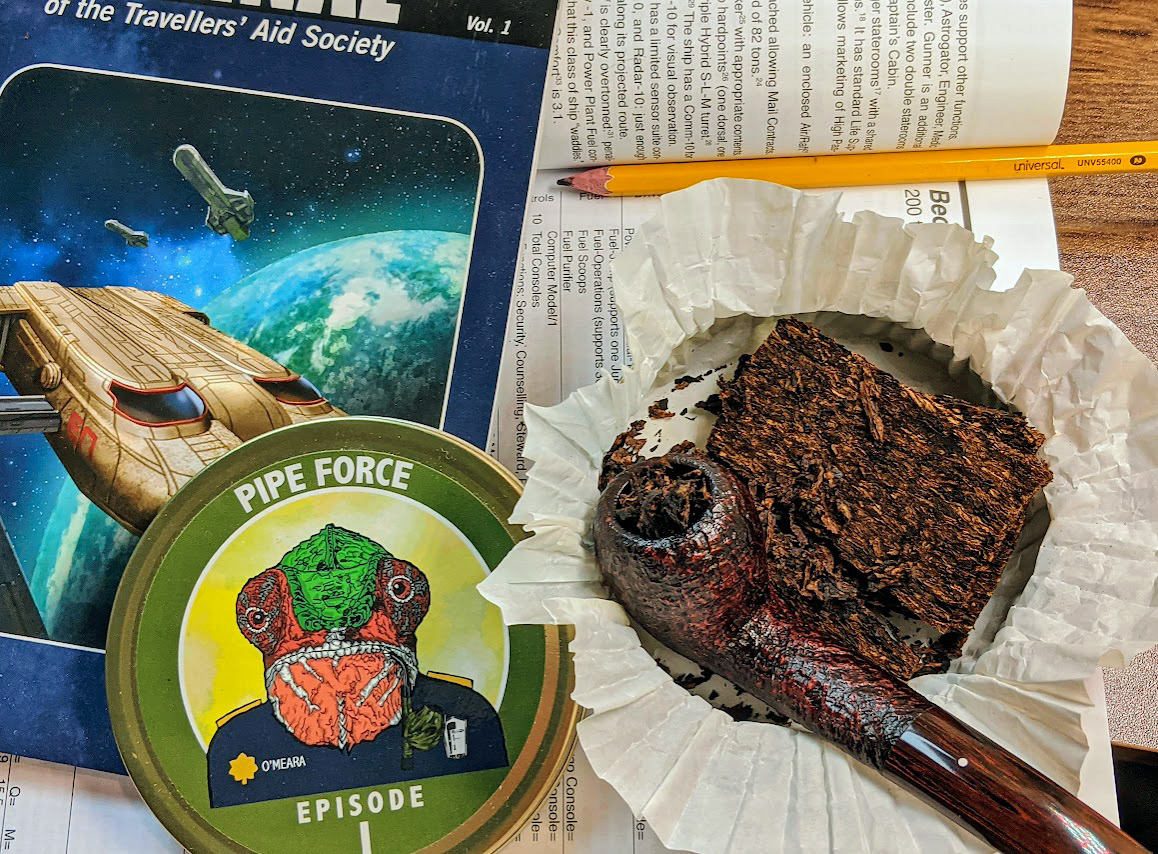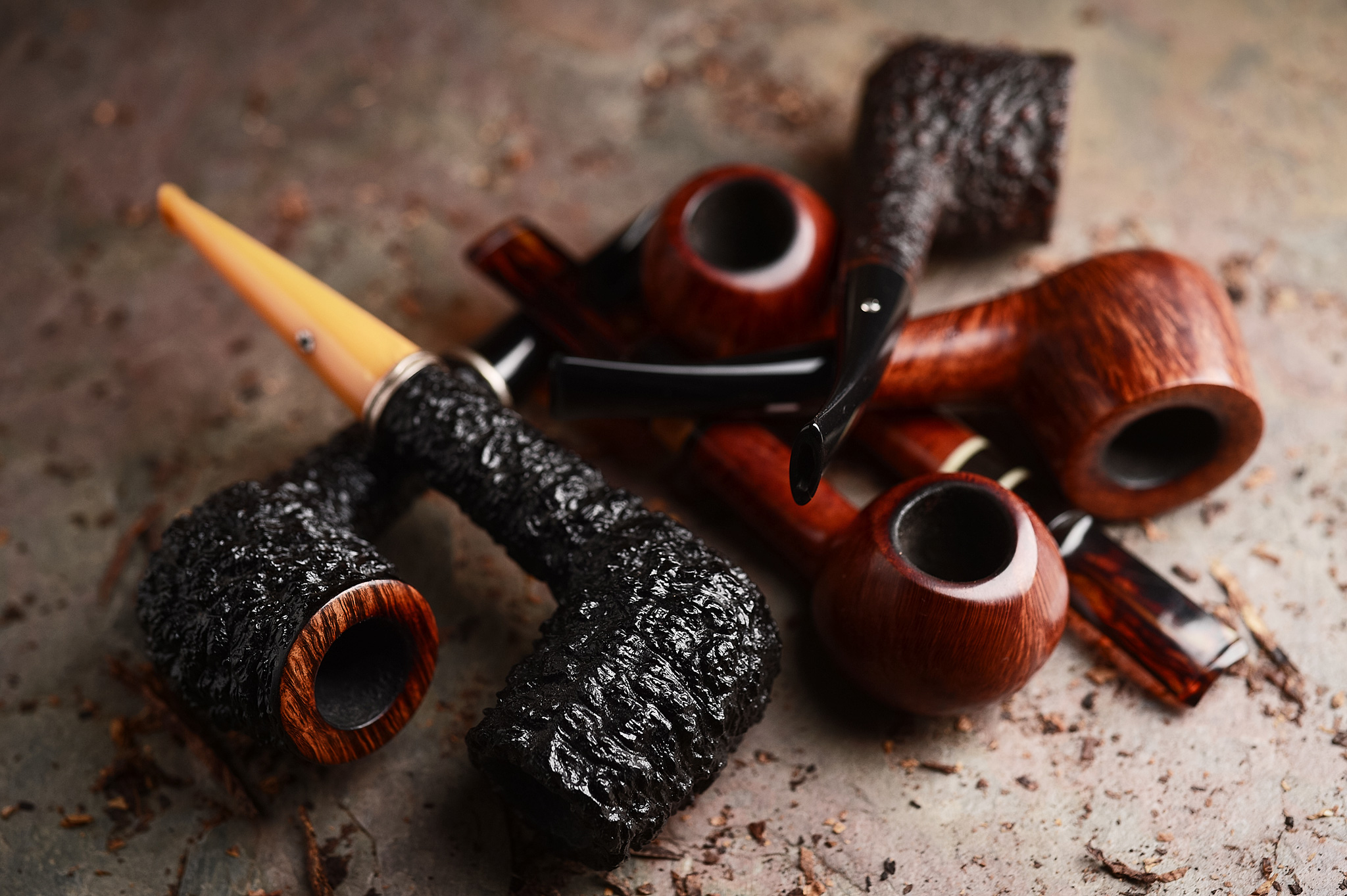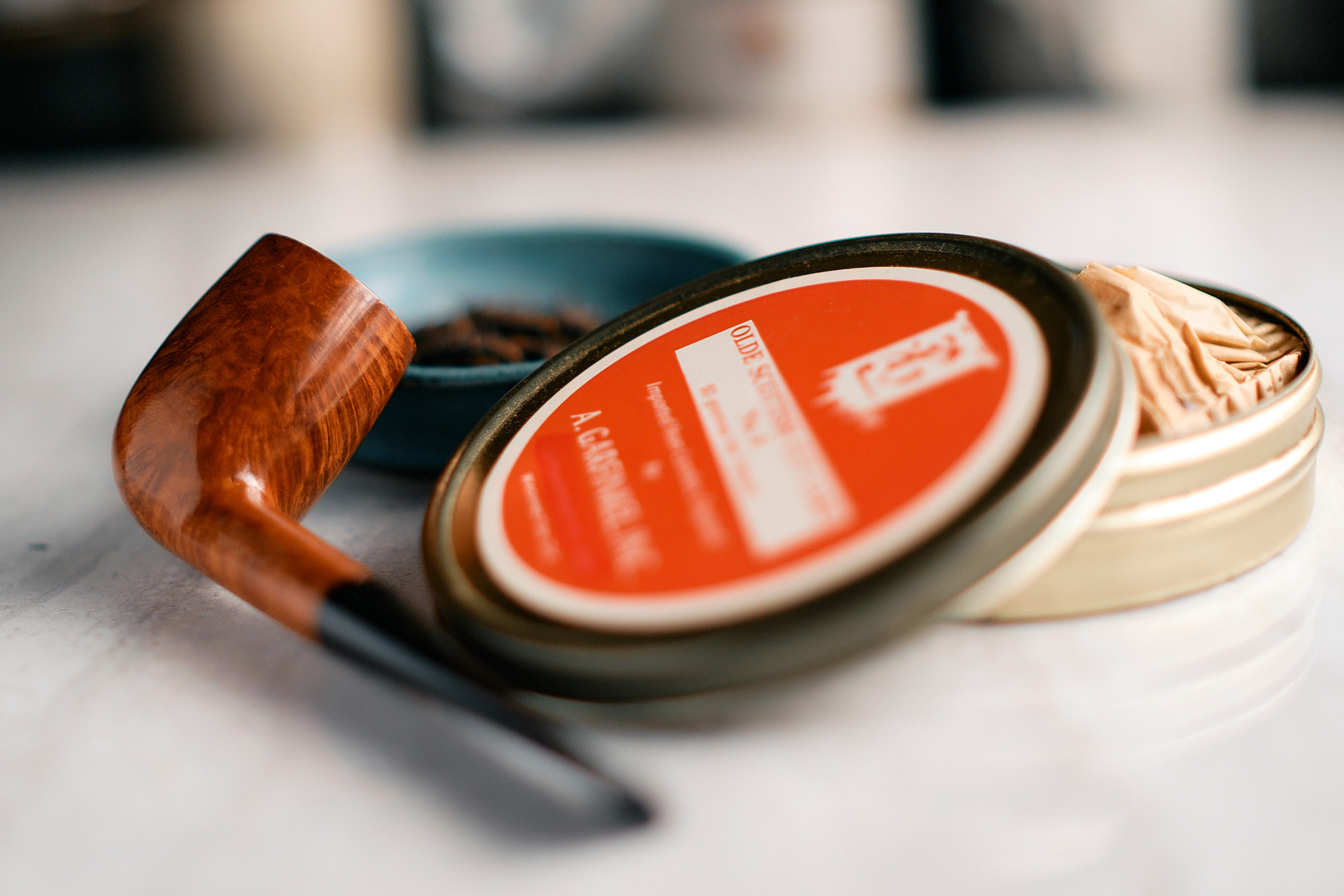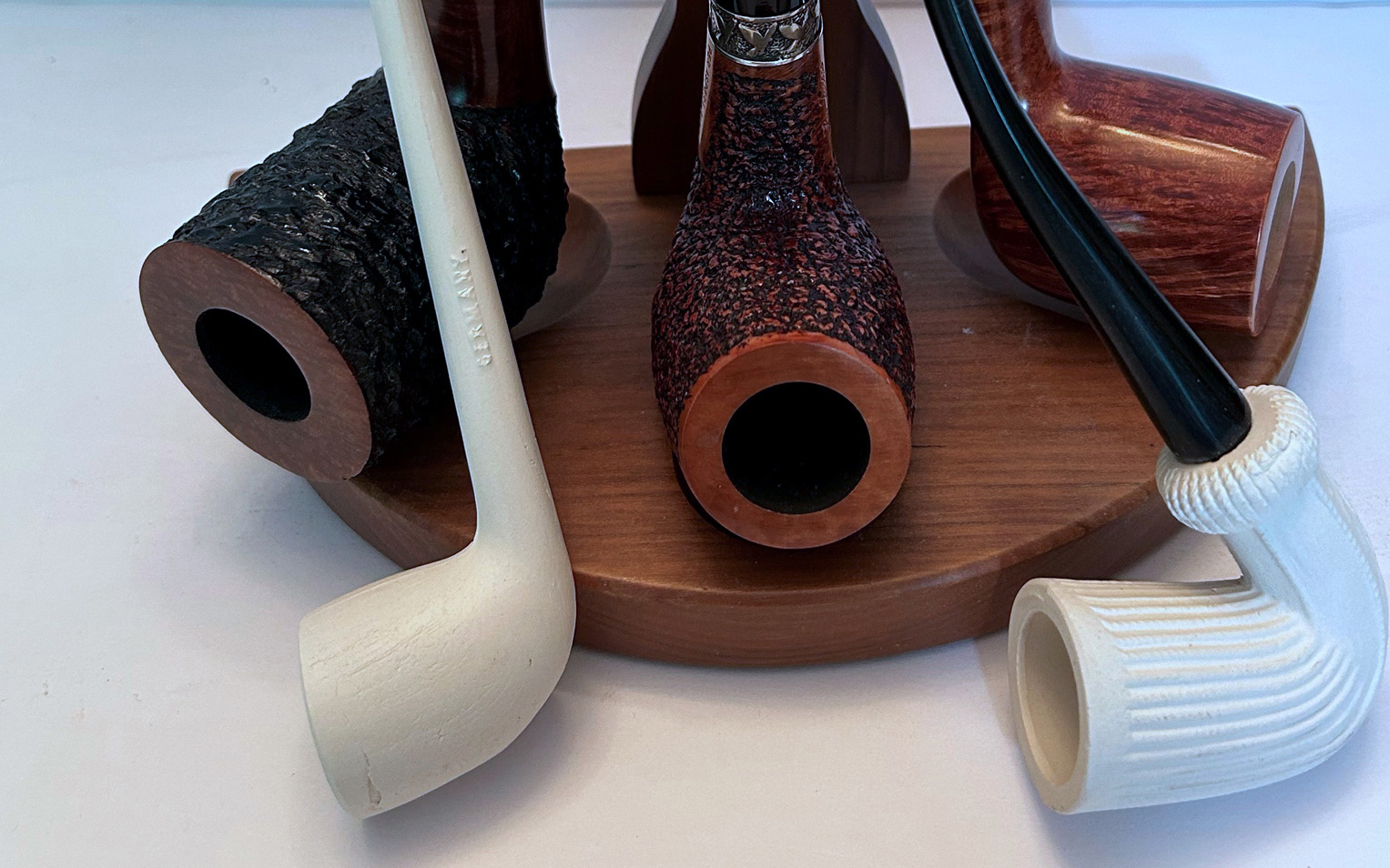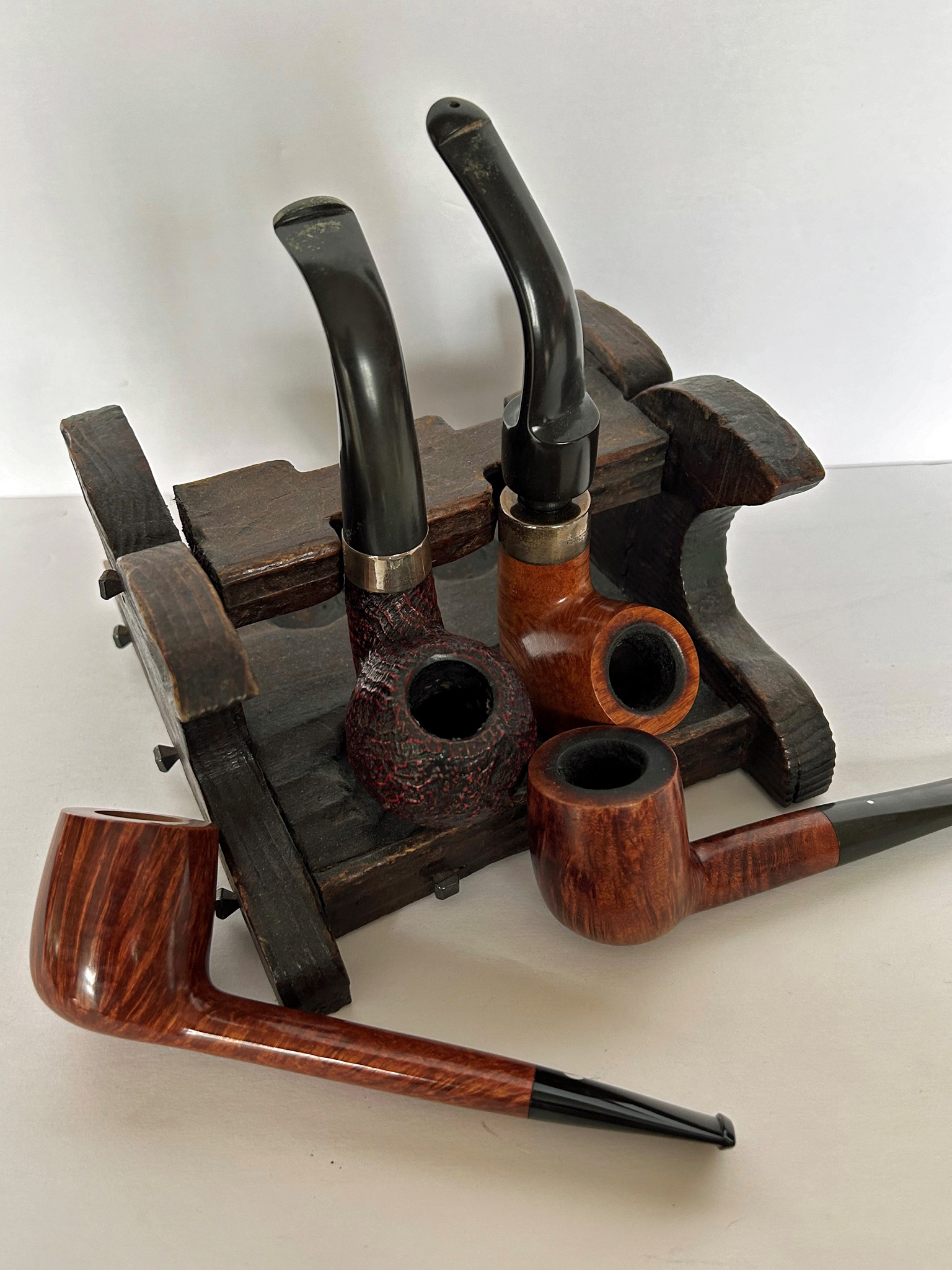Radio Talk Show
- Pipes Magazine Radio Show Episode 612
Welcome to The Pipes Magazine Radio Show Episode 612. Our featured interview tonight is with Pipe Maker Brad Pohlmann. Brad has been crafting pipes for decades. His pipes are works of art and masterpieces in engineering. You’ll often find exotic woods, horn and bamboo as accents on Brad’s pipes. He now shares a workshop with fellow pipe maker Silver Gray. At the top of the show Brian will discuss the best way to sell pipes that you no longer want.
- Pipes Magazine Radio Show Episode 611
Welcome to The Pipes Magazine Radio Show Episode 611. Our featured interview tonight is with Parks Turner. Brian recently called for pipe smokers under the age of 30 that wanted to be interviewed. Parks is 24-years old, grew up in rural Georgia, and is a third-generation Presbyterian pastor. He recently received his Master of Divinity Degree. Parks was always fascinated with pipes. He would pretend to smoke a corn cob pipe when he was just seven, and started smoking pipes for real when he was 18 years of age. At the top of the show we will have an Ask the Tobacco Blender segment with Jeremy Reeves. Jeremy is the Head Blender at Cornell & Diehl, which is one of the most popular boutique pipe tobacco companies in the USA.
- Pipes Magazine Radio Show Episode 610
Welcome to The Pipes Magazine Radio Show Episode 610. Our featured interview tonight is with Donovan Broadway. Last week, Brian called for pipe smokers under the age of 30 that wanted to be interviewed. Donavan is 28, grew up in Nashville and started smoking a pipe during the pandemic. During quarantine, along with his brother they came up with a comic series. The character Donovan created was “an older, wiser gentleman”, so it was decided that he should smoke a pipe. This lead to Donovan’s interest in actually smoking a pipe. At the top of the show, we will continue the virtual tour of Brian’s pipe collection with the Sandblasted Tsuishu Satou pipes. (Tsuishu are very thin multi-colored layers of Japanese lacquer that takes months to produce.)
Tobacco Reviews
- Smoking Hot Summer
I’m a city boy through and through; I’d always thought of plants as either the green background of the generalized concept of “nature”, or specifically the products we extract from them: lumber, food, and of course fine boutique tobaccos. Until recently, that is. A red oak acorn gathered from a place of some significance to me took root this winter, and with it grew a sudden appreciation and fascination with the world of botany. It gives me real joy to learn how to listen to plants, understand how to nurture them, and contemplate how growth is a reflection of their struggle through life. In my horticultural endeavor I find the same peaceful zen practice that I also seek while enjoying a pipe. My houseplants have been thriving in the early heat, and practicing some planty chores while taste testing a variety of recent releases helps maintain some balance and equanimity in an otherwise chaotic world. Sutliff has been churning out new concoctions left and right lately, so let’s take a brief look at two of them. The first piqued my interest as it delves into the past, resurrecting a blend from Sutliff’s estimable vault: 175th Anniversary Blend“The Old Boss”. It’s very much a blend for a clencher; one can imagine the eponymous gentleman pictured steadily puffing like a steam locomotive while reviewing quarterly budgets, then stalking through the factory floor with a stern vigilance on his face. Celebrating our 175th Anniversary, it was only fitting to bring back The Old Boss, presented with founder Henry Sutliff’s portrait just as it was over a century ago. We dug into our vault for an old classic. Before Mixture No. 79, before Heine’s Blend, there was The Old Boss—a Latakia heavy English with the finest Red Virginias and Turkish leaf, a touch of Perique for spice, and Burley to round the edges. Light up and enjoy this throwback and celebrate 175 years with us. “Latakia heavy” is a diplomatic way to phrase it, as the first rush from the tin attests that ol’ Henry is either about to give you a promotion or a pink slip. Notes of waxy leather, a hint of graham cracker, salty driftwood, and old ledgers dominate the bouquet, as if this blend was formed by invoking the ghost of Mister Sutliff and importing it directly into the tin. Despite the vintage heaviness implied by the aroma, in the bowl it is a surprisingly gentle smoke. Presented in thick and loosely-pressed crumble-cake slices, it requires some drying time to prepare. Once packed it tends to stay lit easily and smoke down to dregs without too much tending, even in a capacious bowl like the Savinelli Autograph pictured. Like the tin art, it stays squarely in the vintage vein of flavors true to the bouquet; the tobaccos are balanced in such a measure to downplay sweet notes while not letting the Latakia overwhelm, instead leaning into the woody and leathery end of the spectrum through to the heel. The Turkish leaf steers the experience, the Perique is more an impression than a top spice, and there, at the end, a hint of roasted chestnut from the burley; a lightly floral vanilla that lingers on the palate between puffs. All in all it’s a very sturdy and enjoyable blend that delivers on its claims, worth adding to an order to try something new but perhaps not to cellar deeply. Shifting gears for a moment, next we sample the latest limited edition from the Seattle Pipe Club marque: Gentleman’s Rum Vanilla. The tin aroma is indeed refined in a gentlemanly sort of way, with rich sweet rum and vanilla wrapped in dark woody overtones, and again presented in thickly-sliced krumble cake. Notably, the tin contains a full two ounces of tobacco described as: This exclusive blend features loose cut rare Brazilian and domestic Virginias, luxury Burley and sweet black Cavendish meticulously slow aged for a full 30 days in oak rum barrels. Preferring to lounge in my club chair with a notebook and smoking jacket for this tasting, it’s easily crumbled and well-suited to a Brigham patent-era bulldog. Still rather moist in the tin, I prefer giving it enough drying time that it won’t stick together when pinched but not so dry that it will crush. Sutliff certainly has dialed in on making a rich and redolent Cavendish, with exquisite top dressing and real depth from being barrel-aged. The smoke was consistent top to heel, never biting, though best sipped to keep it from turning toward sour. A perfect smoke for mixed company, it delivered great flavor as well as room note. I found it paired best with unflavored seltzer to wash the palate and give a hint of salty counterpoint. Digging toward the bottom of both Sutliff tins also led to a bit of heresy—namely, mixing the vanilla in with the English in equal portion—and I dare say they each improved the other. “The Old Gentleman’s Rum Bossilla” could be a thing…maybe. I’m sure Joe would approve. Finding the time to also sample a GL Pease blend that had flown under my radar, Penny Farthing ended up in my basket on a recent stop at Barclay-Rex. Something from Greg’s laboratory is generally a safe bet; I haven’t found any that I hate yet, at least. There are many that I love and cellar deeply—Cairo perhaps above them all; the JackKnifes(jackknives?) and Triple Play, of course; new favorite géométrie, recently reviewed here. Tons of Haddo’s Delight, natch. Now, in Penny Farthing, I’ve found one to add to the “when I feel like smoking it, nothing else will do” list. Slotted into the brand’s Old London series, Penny Farthing is a diametric departure from plug tobaccos, a style that many of the GLP offerings re-energized in the US market: A shag-cut blend of bright and red Virginias, spiced with Louisiana Perique and a hint of fire-cured dark Kentucky, easy to pack, easy to smoke. Sipped gently, Penny Farthing opens with a sophisticated […]
- Sutliff – Pipe Force Episode I Tobacco Review
Before we begin, I should tell you: this tobacco review is being written by an A.I. Not the fancy new GPTs or their ilk; no, this is last century’s meat-and-bone, all-organic model. To be fair, a large part of what we call knowledge is merely the accumulated perceptions and impressions gathered from a life wandered through, synthesized into a spongy mass of what-it-is-that-we-think-that-we-know. The algorithm for this prompt is simple enough: pump thousands of bowls of smoldering plant matter into a gaping maw, cross-reference the chemical sensations with all other matter previously ingested or inhaled, sieve it all through the diffuse and fractal twin lens of memory and emotion, and churn out a panoply of adjectives that attempts to convey the sensations to someone who hasn’t experienced it yet. Odds are that a diligently trained monkey could succeed half the time; if this reviewer nears fifty-one percent then that would qualify as an unrivaled success. There must have been some similar musings perambulating through the mind of Per Jensen when he began his mad scientist routine at Sutliff with the Pipe Force project, which brings us to the current mixture under the microscope—Sutliff’s Pipe Force: Episode I. Here again are the unusual ingredients that engendered the series, with the stoved Rustica being the defining voice in this composition. From the tin: The Latakia-forward English mixture offers plenty of smoky flavor from the fire-cured leaf, which is artfully harmonized with floral, earthy Stoved Rustica. A mixture of high-grade Virginias imparts a natural sweetness. Katerini, the sole Oriental component, offers herb and spice notes bringing complexity and nuance to the flavor profile. It’s certainly Latakia-forward, with the stoved Rustica doubling up on the rhythm section like a second bassist. A first whiff from the tin releases the aromas of shoe leather and hide glue in a base of clay soil with a campfire wafted over it like last night’s beach party. Once it’s been accustomed to oxygen again, subtle hints of sweetness poke through from the Virginias: lemon rind, light milk chocolate, the dregs of a peaty Scotch, and muddled cherry. Old regulars like fresh-sawn oak and tilled earth are there, of course, with distinct notes of truffle, creosote, damp peat, and pine bark mulch. As an aside, I’ve been re-potting my camellias and the similarity of aroma to the ericaceous soil mix is notable; the Katerini really brings the unique depth of its vegetal complexion when supported by the Rustica and afforded more voice in the mix. The smoky Cyprian Latakia, in turn, is backed by equal earthiness from the Rustica, which overall exhibits a profile similar to dark-fired Kentucky; it leans more toward the woody and vegetal end of that spectrum, echoing and amplifying those traits of the other constituents. The tobacco is presented pressed and cut into a couple of thick, hearty flakes in the tin, lightly moist and easily crumbled to prepare—I prefer mine with a bit of drying time. The out-of-this-world tin art for this episode in the series is Major O’Meara smoking a cavalier. In the absence of confirmation, I’m going to hazard a guess he’s of the Ithklur species. The first taste from the light is sweet, with hints of that milk chocolate dancing around the edges. The Virginia leads the smoke through the top of the bowl, and orchestrates it well. Thoroughly smoky with lemony, grassy highlights from the Virginia spectrum, it soon segues into the mid-bowl profile: heartier, smokier, with the flavor leaning to the mildly acrid and tangy tinge that is the campfire-esque signature of English blends. Caution advised, it can turn overly bitter if pushed—this is where one’s sipping technique is required to maintain the fullness of flavor through to the heel. I did tend toward a lot of relights, though it may have as much to do with technique as with the blend. Pacing is also important as the nicotine starts to manifest; though the Rustica’s contribution has been tempered well by the stoving, it can certainly upend an empty stomach. At the end of every bowl, the mouthfeel somehow gets better. The balance of sugars in the tobaccos would seem to be spot-on in this regard. I started out my tasting in cobs, then cut short an unpleasant bowl in a meer, and finally landed on my best instrument with the lovely Dunhill 4427 pictured, a quaint group 4 shell briar with a gentle curve and Cumberland stem supporting a perfectly executed acorn bowl. It surprised me here, as I’ve learned through the years that I generally have the best experience with English blends in large, wide bowls. With this blend it seems that to get the best out of the Katerini’s somewhat diaphanous influence the smaller bowl fared much better. Room note is very English, so the company you keep will either love it or hate it, and it doesn’t linger too much. I find it paired best with a strong coffee; Sumatran beans complement the flavors well, as do Ethiopian if a lighter brew is preferred. Overall impressions of the blend are that it’s a curiously interesting take on the English genre, almost a reductive reconstruction of the theme using the unique components. This blend, if nothing else, expanded my vocabulary of sense perceptions with the uniquely treated leaf. While the average human can distinguish approximately one trillion (1,000,000,000,000!) different aromas, multiplied by seven basic tastes, and wholly dependent on variables from body chemistry to atmospheric conditions, our overworked and underpaid simian brains can’t effectively catalog them all. Our pet adding machines are exceedingly good at this, however, and someday soon they’ll be the ultimate and unequivocal authority on what something tastes, smells, looks, or even feels like. Until that time, friends, revel in the moments that can be stolen to savor over a bowl of Pipe Force: Episode I.
- McCranie’s Roanoke Tobacco Review
The winter winds are really whipping at the windows here in the northeast, lashing out the last gasps of the season. Not the best weather for outdoor pipes, frankly. Luckily here I am, snuggled tight inside next to a purring cat and a cozy heater, with a mug of warm chai, a book filled with adventures in tropical realms, and a pipe full of the taste of warmer climes. This month the particular blend in question is McCranie’s Roanoke, a delicious two-ounce serving of summertime-in-a-jar. A tobacco house patterned after the classics, McCranie’s is well known locally to Charlottians, and to pipe tobacco aficionados the world over. From its humble beginning as an Edward’s franchise back in 1979, its current incarnation is led by its third-generation namesake Matthew McCranie, who was interviewed by our very own Brian Levine on the PipesMagazine.com radio show not too long ago. (Interview here.) Ask any veteran piper about McCranie’s Red Ribbon or Red Flake and they’ll likely get a wistful, far-away look in their eye as they recall the singular nature of those monumental marques that will unfortunately never be repeated. The McCranie’s story is intricately tied to the McClelland story. McCranie’s landmark blends Red Ribbon and Red Flake, which showcased exceptional single-crop, single-year, local Carolina offerings, were processed and tinned by McClelland, and with the passing of that blending house a vacuum was created that was felt far and wide across the tobacco world. Not to be deterred, Matt McCranie dusted off the family blending cap and set about sourcing leaf and creating a whole new legacy for the brand. So it was that while shopping for review blends I navigated to the McCranie’s website and decided to sample some of their new offerings—and am I ever glad that I did. As I get older I find that it sometimes takes a more conscious effort to break out of habit and routine; I’ve hoarded plenty of Red Ribbon and Flake tins in my own cellar, yet had only tried one other of McCranie’s offerings, the also-erstwhile Murdock’s Pipe (a delightful blend, but not to my general preference). Well, it was high time to rectify that situation. The first thing of note is the presentation: McCranie’s own-label blends are now being offered in glass jars holding a full two ounces of leaf. As a matter of course I generally buy tobacco with the intent to set the majority of it aside to age while I whittle my way through a tin or two, and stocking up with glass jars makes me feel better about that investment in future enjoyments. The jar itself sports a simple label bearing the McCranie’s logo, the name of the blend, and a portion of the William James Linton engraving The Lost Colony, referencing the famous lost colony of Roanoke located in Dare County, on the Outer Banks. From the website we find the description of the blend: McCranie’s Roanoke is a rich and complex blend made of Red, Gold, and Dark Virginias with a helping of Louisiana Perique, perfect for Virginia Perique lovers. The Red Virginia provides a sweet and tangy flavor that complements the bold and spicy notes of the Perique. It’s a tobacco meant to be savored slowly to fully appreciate the flavors that develop throughout the bowl. Simplicity is what McCranie’s does best, and Roanoke is a perfect example of that simplicity in all its glory: a Virginia-Perique blend par excellence. Unscrewing the lid releases a burst of a sweet, tart bouquet that immediately carves out its own place in the genre. Top notes of raspberry jam and buttered toast hint of the tobacco’s sugary richness, and are a tantalizing departure from the more common lemony complexion of most VaPer blends. Some airing time brings mid-tones of driftwood and clay soil—a natural allusion to its namesake—along with more typical VaPer notes of mulled wine, ketchup, stone fruit, milk chocolate, and leather, along with the telltale nose-tingling that accompanies a healthy portion of Perique. The leaf still feels a little young at times, with the tiniest of edges and errant notes on occasion—this does, however, bode well for its future in the cellar, and did not intrude on the smoking experience negatively. The supple, chocolatey ribbons come at a perfect humidity for packing directly or allowing a short drying time, and the jar keeps a clear concentration of the aromas contained like a brandy snifter, without the cardboard or paper wrapper in tins that can color the aromas, if ever so slightly. In the bowl, Roanoke is a midwinter’s dream. Smoking lightly and effortlessly despite its obvious richness and youth, the first ounce disappeared within a week, before I’d even finished my tasting notes. It’s an easy one to recommend as an all-day blend—my own smoking habit has decreased significantly in the past several years and leaves me readily susceptible to a too-sharp Virginia tongue bite, but this never even nipped at the edges. On the contrary, it delivered a rich and colorful smoke bowl after bowl in the same pipe, with a flat-cola mouthfeel and aftertaste better than any blend in recent memory; I’d place it alongside an aged Escudo or Sunday Picnic in a heartbeat. The Perique component is at a good amount, alluringly drawing out the complementary flavors of the variety of Virginias employed and providing a finely nuanced cohesion to the overall. Repeated rations in the same pipe were never an issue, and in fact seemed to improve the flavor of each subsequent helping. For all its flavor it’s notably mild in nicotine, and the room note, though it lacks the richness of the direct smoke, casts a pleasant afterglow that doesn’t linger overlong. This blend certainly tells me that McCranie’s is still a name that carries its weight in the pipe world. Not many tobaccos make me want to plan a pilgrimage to their source. (I wonder what the airfare to Charlotte is this time of year…?) Also a blessing and a curse […]
Fireside
- Heisenberg May Have Been Here
Some time ago, a good friend, an astute and seasoned pipe man, brought to my attention a very long running discussion over whether two tobaccos were, in fact, the same thing under different names, or were they actually different products. He sought my thoughts, more out of curiosity and a dive into the pool of conversation than anything else. At the time, I had little to offer him, as I’d only smoked older examples of one of the two, and had never tried the other. It seemed like as good a reason as any to do a little exploration. More than gaining the ability to offer a slightly more educated opinion, a potential answer to my friend’s question, I wanted to find out if the current version of the tobacco I knew was similar to my memories of it in the past. Things like this aren’t what I’m usually concerned about. Most often, simply enjoying a bowl of a favored blend is all I’m after, but going into this with a different intention would present some interesting challenges. When smoking with my critical hat on, all sorts of things might come into the foreground that might otherwise fall into the realms of subliminality. This kind of geeky tobacco stuff is right up my street. This was going to be fun. First, a little background. There is no shortage of examples of blends changing over time, sometimes morphing into something rather different from the original form. In the early 1980s, for instance, when Balkan Sobranie licensed the production of their most famous Smoking Mixture to Gallaher, the formulation was gradually changed over several years, and not insignificantly. While the original formula comprised nearly 50% latakia, the final recipe had the quantity of the smoky stuff reduced to about 35%. By doing it gradually, regular customers acclimated to small incremental changes to the point where they’d only notice a difference if comparing a fresh tin to one several years old, and by that point, the effects of aging would be more than sufficient to render subjective comparisons nearly meaningless. Other times, when a blend’s manufacture changes from one company or location to another, changes can occur less intentionally. Different leaf sources, different manufacturing methods, different water supplies and even environmental factors like the natural microflora in the air can result in changes to the final product, some subtle, some less so. Too, the branding of the same tobacco under two or more different names is not historically unusual. As one example out of many similar, Davidoff’s Royalty mixture, produced by McConnell in London, was at one time only available in the European market. When the Elephant & Castle brand was created in the early 1980s, their blends also manufactured by McConnell and imported and distributed by Marble Arch Ltd, Royalty was sold in the US as Cromwell. Had the two products been available in the same markets, it’s likely each would have had its adherents and its detractors. Branding can have that effect on perception. Years ago, my friend Marty Pulvers told me about a customer who had relocated to San Francisco from New York. He came to Marty’s shop looking for something similar to his favorite blend from his old haunt. Marty called the shop, and asked about the blend, which turned out to be Lane’s 1Q, one of the most popular and successful bulk aromatic tobaccos ever produced. Of course, Marty could provide his new customer with the same tobacco that he sold under a different name. A couple weeks later, the fellow came back and said, “It’s very good, but I like my old blend a little more.” Back to the future. Here I had an opportunity to explore two tobaccos, made at the same time, in the same factory, by the same methods, but sold under two different names. I acquired a fresh tin of each, selected a few pairs of similar pipes, and got to “work.” I also pressed into service a pair of matched pipes made for me years ago by Peter Heeschen made from the same block of briar with identical geometries; these are as close to one another as two pipes can be, and for as long as I’ve had them, they’ve been treated equivalently. I smoked each blend alternately in each pipe, recording and replicating the weight of each fill to eliminate the one variable I had some control over, and kept track of my impressions. Before starting this exploration, I was slightly biased towards the idea that the two would be different. In reading through some of the seemingly endless threads on-line, I saw more than a couple side-by-side photos that made the two at least appear dissimilar, a fact confirmed by my own visual perceptions (see photo). And while many insisted, some citing “reliable inside sources,” that there was no difference between the two, others were equally confident that they were different. Perhaps most interestingly, amongst those who found them different, there was surprising consistency in their individual characterizations of the two tobaccos. Had they influenced one another? The tin aroma of each was subtly different. One had a deeper, richer, “darker” aroma, with a toasted almost treacle-like character, while the other was a bit sharper on the nose, expressing more of a bright flue-cured astringency. Both presented that special perique funkiness that we all know and love, but in the first case, it was more in the background and on the fruity side, while in the second, it was more prominent and slightly peppery. (Perique is that way. It can be quite a chameleon, interacting with what it’s blended with more dramatically than any other tobacco I know.) Some of this difference could result from the two tins being made a few months apart, but to me, the differences were more likely from the tobaccos themselves. The taste of each was, at least at first, generally reflective of their respective tin aromas. One is deeper, slightly sweeter, the other […]
- Bad Advice?
When I first started with the pipe as a quirky and precocious teen, the only tutelage I had at my disposal were scenes from old movies in which a well dressed chap would stick his pipe into a pouch, scoop tobacco into the bowl and press it down unceremoniously with his thumb. Then, with great flourish, he’d strike a match and light the thing with all manner of cinematic excess, puffing up vast clouds of smoke falling just short of completely obscuring his visage. While it may look good on film, it’s a terrible approach to actually enjoying the thing. Somehow, though, this “technique” seems to have survived in the contemporary vernacular, at least to some extent, even with bit-loads of information handily at our fingertips that should dissuade us from the practice. But, at the time, this misguided approach was all I had; it’s no wonder my early days of puffing were fraught with difficult lighting, harsh, bitter smokes and tongue bite, all culminating in a fireproof mass of ye old soggy dottle in the bottom of the bowl. Ultimately, the resulting frustration made me give up the pipe, at least for a while. While the idea of it was still very appealing, the practice of it was not. It wasn’t until a few years later when, still full of curiosity and romantic notions of pipe smoking, I wandered into a real tobacconist’s shop, and learned my “method” was a long way from the techniques that would bring me to any sort of pipe smoking bliss. So, after my poor start, and under the guidance of someone who actually seemed to know how to do it right, I was given the opportunity to approach the process anew, this time with much greater success. It was only because I was both perseverent, and fortunate to have a local shop staffed with knowledgeable people, that I’ve been able to enjoy the experience ever since. At least mostly… How many fledgeling pipe smokers have simply given up on an enjoyable pastime because of similar early mis-starts? Fortunately, today, it’s not hard to find helpful guidance at the press of a key or ten. But, at the same time, not all roads lead to Valhalla, and sometimes the advice offered might well be labeled with, “Here be dragons.” The other day, I came across a short video on-line in which a well-meaning tobacconist suggested packing a bowl of an “English” mixture “nice and tight.” Perhaps somewhat ironically, I was smoking, or trying to smoke a bowl that I’d filled on auto-pilot, packed too tightly, and not only was having the devil of a time trying to keep it lit, I really wasn’t enjoying the acrid smoke the tobacco issued during the brief periods in which it was actually burning. “No, no, NO!” I found myself muttering at my pipe, and at the figure on the screen, my protests joined by the guttural growling noises that sometimes accompany my discontent. Defiantly, I grabbed a pipe nail, shoveled out the dense, asbestos-like clog from the bowl, swabbed out the shank with a pipe cleaner, more out of habit than need since I hadn’t actually smoked enough of the mass to foul the shank, and started over, this time paying proper attention to what I was doing. (For as long as I’ve been doing this, I still screw it all up sometimes.) Much better. This got me thinking about a couple things that are so important to the maximal enjoyment of our pipes, yet not often enough discussed, namely how different tobaccos respond to variations in filling density, and moisture content; two separate but related parameters. Once I’d been shown the proper way to fill the bowl, or at least a proper way, everything had changed for me. I also began drying my tobacco down as a matter of course. Suddenly, there was greater cooperation between leaf and flame, the smoke was rich and flavorful, and it burned mostly to the bottom of the bowl with few relights. Given that, at the time, I smoked latakia mixtures almost exclusively, there didn’t seem to be a reason to explore beyond my “new” approach. It wasn’t until my attention turned in the direction of Virginia blends that I had to look a bit deeper. The same technique that worked so well for me with latakia mixtures resulted in bland, and often harsh smokes with Virginias. I attributed this to the tobaccos, convincing myself that I just didn’t like the stuff. At one of our pipe club meetings, I was talking with a friend who smoked Three Nuns exclusively. When he offered me a bowl. I thanked him, and told him that I just didn’t seem to get along well with Virginias, that they weren’t for me. “Maybe it’s the way you pack them. Here, let me fill your pipe for you.” I watched as he rubbed out a few coins to fine ribbons, moister than I was then accustomed to, and filled the bowl carefully in stages, pressing it tighter than I would have. Prepared for a nightmare, I was instead treated to a pipe dream. The tobacco smoldered slowly and almost continuously, delivering a rich, cool, sweet and delicious smoke. After that, I spent some time exploring the impact of these two variables, moisture content and packing density, on different mixtures and blends, always with similar results. Latakia mixtures, and to a lesser extent, those with a high percentage of oriental leaf, taste and smoke better when they’re on the dry side and the bowl is filled loosely, while Virginia blends tend to work best with a little more moisture and a denser fill. Burleys seem to work best somewhere in between, except for cube-cuts, which don’t like to be packed with much pressure at all. (Gravity fill, tap the bowl to settle the cubes. Repeat until full.) For such a simple act, pipe smoking is filled with undefined complexities! The point behind all this? Often […]
- FOMO
I confess. I’m a Latakiaphile. Ever since I first smelled the smoke of the dusky leaf, I’ve been in love with it. I know this is no surprise to anyone who has followed any part of my weird journey through pipedom, but I wanted to state it openly, get it off my chest. Mostly, because I seem to have been in something of a weird state of denial about this fact myself for some months. It started innocently enough during the heat of last year’s summer, a time when I find myself feeling the gravitational pull of lighter tobaccos. While winter weather and bigger, bolder Latakia mixtures have always been my ideal companions in the colder, moister clime, they can be a bit overwhelming to me when the mercury rises. While I enjoy the taste and aromas of those first few puffs, as the bowl progresses, my senses soon feel fatigued, overwhelmed, like putting on a comfortable but heavy top coat and wandering out into the blazing sun. In the summer months, I have always turned to “lighter” blends, sometimes with just a whisper of Latakia, more often with none at all. Virginias, with or without the added condiment of perique or oriental leaf are just the ticket when short sleeves and tee shirts are the uniform of the day. Even burley blends tend to feel more apropos then. I know there are many who smoke the same blends year-round, but I’ve never been one of them. If I’m honest, I am a little jealous of those folks. It’s a bit of a curse to have my tastes tied inextricably to uncontrollable forces of nature. (Though, I do recall a rather oddly delightful experience of finding myself, exactly once, smoking a pipe in the shower. Another story. Another time. Maybe.) Last year presented no exception to the rule. Once spring had come and gone, I put away the dark mixtures, and turned to the softer, gentler side of tobacco goodness. I always enjoy this little “reset,” but equally, I look forward to the return of the cooler days and colder nights when I can come back home to the comfort of those mixtures that have always provided me with an indescribable solace. I love fall and winter the most, and not just for smoking. I don’t really hate the sun, but I’ve never thrived in its heat; my constitution prefers cooler weather. I’ve always been a fall and winter lover. But, something strange happened last year. Even when the temperatures dropped, even when the air got misty, the rain began falling, and I traded short sleeves for sweaters, I kept reaching for my summer blends. Occasionally, I might dip into the jar of Westminster, prepare a slice or two of Spark Plug, or reach for one of my vintage tins of Orient Express #11 or Bengal Slices, but I found myself routinely returning to the lighter side of things when it was time to fill my bowl. Nothing about this should be upsetting, of course, but it’s just not who I am. It’s out of character. It’s like I was subconsciously denying something that is fundamental to the very core of my pipe smoking existence. Looking back on it now, it feels like I was in some strange parallel universe, an alternate reality. It strikes me as just plain wrong. It’s an odd thing. For most of my pipe smoking life, I’ve always enjoyed these forays into the lighter side of things, but at the same time, my craving for Latakia forward mixtures has always ruled. I remember when I first began exploring Virginias, I’d reach the end of a bowl, feeling somehow unsatisfied, and would immediately want something else, something smoky to scratch the itch that remained. As I became more familiar with them, that itch gradually subsided, but never fully disappeared. The pull of the dark side remained strong. I’d spend the summer enjoying my Virginias, but always looking forward to the season’s change so I could once again dive happily into the deep, smoky richness of my most favored leaf. Last year, though, I kept on an almost steady diet of Virginias all summer, of course, but also right through the cold and wet months. On a whim one cool, blue day recently, as the sun revealed itself from behind wispy clouds, I pulled an open tin of my beloved OE11 from the Tupperdor in which the open tins reside, savored the aroma for a few minutes, then filled a bowl with those luscious dark ribbons and enjoyed an almost magical smoke, rich, deep, satisfying, the wonderful incense-like scents enveloping me as I puffed in absolute bliss. Then, reality hit me over the head. With spring teasingly peering out from around the corner, last year’s winter having pretty much come and gone, I realized I’d managed to miss out on all those wonderful cold, damp days and the perfect harmony they create when the misty air embraces the leathery, campfire aromas and rich flavors from my beloved mixtures, and I didn’t even notice. It’s not just that the window of opportunity for my yearly Latakia fest was about to be slammed shut, but, worse, it’s that I wasn’t even aware that I was missing it. It’s not that my tastes had changed, or anything so dramatic; I’d simply fallen victim to the power of inertia. I was enjoying what I smoked, and simply, unconsciously paid no attention to the fact that the season was coming to a close. Hot weather is on its way, and if history holds, it’s probably coming fast. Soon it will be time to return full-stop to tee shirts, cold showers and lighter tobacco fare. It feels like I’ve slept through Latakia season, like I’ve missed out, and I’m feeling a little melancholy about that. I’ve got at most a few weeks to catch up, to make up for lost time. Hopefully, we’ll see a few more days of rain before that […]
The Pipe Pundit
- The Contemplative Lifestyle
June is a memorable month for those of us who are absorbed in history. June 6, 1944, marked the beginning of the end of World War II as the U.S. and its Allies landed at Normandy. Here soldiers sloshed ashore under protracted and coordinated German machinegun fire on the deadly but beautiful sandy beaches. Soldiers braved the onslaught and moved up the sand dunes, foot by deadly foot. American and Allied aerial fighters and bombers, along with famous glider troops, bombed and landed in Normandy fields of glory. Pipes may not have been the most popular wartime smoke—cigarettes took that spot—but many a soldier enjoyed their pipes to relax when possible from the terror of war. One of America’s legendary generals, Gen. Douglas MacArthur, was rarely seen without his famous corncob pipe, either wading onto the beachhead or behind a military desk. It’s probably safe to say the famed general made Missouri Meerschaum in Washington, Missouri, the celebrated and historical manufacturer of the sweetly smoking cob, one of the most popular pipes on the planet. Missouri Meerschaum will celebrate its 155th Anniversary Sept. 28, 2024. Now, that’s worth a cob and a smoke! And by the way, the highly decorated general served in World War I, World War II, and the Korean War. Dunhill sent pipes to the troops in World War I but struggled to continue its production of pipes and tobacco during the blitz bombing of England by Germany in World War II. And Peterson Pipes of Dublin also contributed pipes to troops in the war effort, according to some reports. What got me dredging up this moment in time is a recent visit to a Knoxville Pipe Club gathering at Smoky’s Tobacco & Cigars in Knoxville, TN. It’s a Pundit favorite haunt from the past. Listening to members of the club exhort the wonders of pipes and tobaccos, even down to repairs, was a Master Class. It was also good to get the world’s problems settled a bit as well. Ahem! And, of course, there was some jovial, all-around fun at the special room set aside by Smoky’s owner, Dave Watson. The Venue is a spacious room next door to the main bricks and mortar pipes, cigars, and tobacco store. It is a rentable space, in which pipe and cigar aficionados have plenty of room to hoist out their pipes and tobaccos. And perhaps a wee dram of something, which kicks off the stories in a good month for history, pipes, and tobaccos. Now for a bit of enlightenment. If you haven’t followed Mark Irwin at Peterson Pipe Notes, then you are missing one of the finest pipe writers, historians, in the writing business today. Irwin focuses, naturally, on Peterson Pipes, but this clergyman, English major with two Ph.Ds. is in a league of his own. He is also a Doctor of Pipes, as well as holding those other impressive academic degrees. Here is what Chuck Station at SmokingPipes.com, one of my all-time favorite pipes and tobaccos writers, has to say about Irwin and the Peterson Pipe Notes blog: “He’s pursued his hobby, and we have all benefited. An author, researcher, blogger, and endless source of information, he shares his passion and his work, and those who love Peterson pipes have struck sterling silver to have Mark among their ranks, while the ongoing dialog about pipes is improved thanks to the quality and expansive quantity of his contributions.” Now, reading Stanion’s 2022 Mark Irwin: Doctor of Pipes and Peterson Researcher Extraordinaire in Pipe Line, I also discovered so much more about Irwin and his cerebral pursuits. It is a must read for all of you history buffs, pipes, and tobacco lovers. Irwin’s blog turned 10 years old in May. A big achievement in the fast paced tik toking world of today. Back to my original pursuit, Irwin created a fabulous PDF recording from his lecture at the 2024 Chicago pipe show. The title is The Life You Save May Be Your Own. Or, as Irwin completes this thought: “Pipe Smoking and the Contemplative Lifestyle.” Honest, you will really enjoy this You Tube production by Irwin. And now, it’s time for a Pipe Smoker of the Past: I start with one of my old, special friends, the late historian-author Shelby Foote. I was fortunate over time to interview Shelby on several occasions, in person and by phone. He was always so informed and informative. Not to mention his Magnum Opus, the three-volume non-fiction trilogy, The Civil War: A Narrative. My real joy was the opportunity to interview the famous Civil War historian and novelist in his Tudor-style home in Memphis, TN, in his bedroom-office, no less. Shelby was born Nov. 17, 1916, in Greenville, Miss., and died June 27, 2005, in Memphis. The Civil War defined us as what we are and it opened us to being what we became, good and bad things… It was the crossroads of our being, and it was a hell of a crossroads—Shelby Foote, The Civil War: A Narrative A parting shot: If you have gotten this far along with the Pundit, it is obvious I am a devotee of history. I was highly influenced in college by English and history professors. Most of whom smoked pipes. Two other profs—physics and philosophy—also smoked pipes. So, I picked up the pipe at an early age. It has been a constant companion since that time. Observing the fellows in Smoky’s was a renewing experience: watching pipe smokers enjoy their pipes and tobacco. Some of them puffed easily and put down their pipes. Tapped the ash, filled with a few dried leaves of a favorite blend, relit, puffed, put down. Repeat. It was a teaching example of how to smoke a pipe without puffing and scorching your tongue . It’s called enjoyment. The “contemplative lifestyle.”
- Pipes Running Amok!
Pundit is a pipe smoker who never sleeps. No, that’s not right. Pundit is a pipe smoker who is always thinking about pipes and tobacco. Even in his sleep. Well, that’s close enough. It’s May. Blooming flowers, weeds, trees, and grass, have taken over the yard, and pollen scatters and sprays like rain. We asked for spring, and we got it in barrels. But this is also a time when thoughts turn to new pipes and new tobacco blends. It’s like that runaway elephant when it freed itself recently from a circus show in Butte, Mont. The Pundit herd rules, but it is too large, despite thoughts and urges for more pipes and more tobacco. What to do? If you are like Pundit, you eat, sleep(less), and think pipes and tobacco blends. Right now, everywhere, all pipes, all the time. Call it pollen-crazed mind. And just so you know, Pundit has already set aside a stash for new pipes. We’ll just let the herd run amok. It’s the Butte syndrome. Now that we’ve settled the weather and runaway elephants issue, it’s time for a couple of Pipe Lessons from the Past: Do take your pipe when you go fishing, say. Your pipe pal tends to calm the nerves when the big one takes the bait, doncha know. I once hooked a large brown trout while fly fishing a pristine Missouri trout stream. Its waters glimmered in the early morning dawn and trout were rising to a variety of emerging bugs. Mouth open, pipe drops to the bottom of said stream and heads out toward somewhere in Missouri with the rest of the brown trout. Leaning over to quickly grab the disappearing pipe, my brand new German-produced Puma trout knife drops from the leather sheath dangling from a leather strap around my neck. Don’t become wildly flailing with excitement when you hook the big one and lose a pipe and knife worth more than said fish, hand-tied trout fly, line, and rod and reel! Patience, as in pipe smoking, pays off. Do keep your precious pipes clean with regular pipe cleaners and solutions. I used soft and bristly cleaners with alcohol (50 percent isopropyl). In some cases, it took stronger stuff, grain alcohol, or even special pipe sweetener found at pipe and tobacco brick and mortar shops and online. Uh, I hope it doesn’t need to be said that you don’t drink grain alcohol. A dab on a bristly pipe cleaner will do. Do not ream out the inside of the bowl with that hard-won cake buildup with a pocket knife. Pundit ruined a beautiful Peterson with a pocketknife, ala Jack the Ripper. You can find great tools for that job. In fact, for newbies and veterans alike, check out the Smokingpipes.com “How to Clean a Pipe.” It is a Master Class on the proper way to clean a pipe, inside and out. Do store your treasures in pipe racks. It keeps them safe and out of harm’s way. Refrain from tossing pipes into an old shoe box or drawer. That’s the heartless approach. Do not try to move your pipe racks if fully loaded with pipes. Invariably you will come down with a case of the jitters, like yours truly. Pipes will rock and roll like Elvis and invariably one or two will hit the floor. I broke the stem of a one-of-a-kind Pete, and the tenon out of a wonderfully carved Danish. Mind you, this was in one big rattle-and-roll. And one more final painful lesson learned from the past: If you drop a beloved meerschaum on the floor, it being composed of ancient sea critters and sea shells, will shatter into a thousand and one shards. One of my treasured meers hit the floor and scattered like so much white dust across the floor. Pipes are my BFFs. I have learned over time they deserve attention and TLC. Ok, time for a note or two from Pipe Smokers of the Past : One fellow who was rarely seen without his pipe is Harold Wilson, two-time former United Kingdom Prime Minister. He ran the political show from Oct. 1964 to June 1970, and again from March 1974 to April 1976. Wilson was born March 11, 1916, in Huddersfield, West Riding, Yorkshire, and died May 24, 1955, in London. He was looked upon, politically speaking, as the people’s Prime Minister who smoked a pipe and was down-to-earth, just a regular guy. I’m an optimist, but an optimist who carries a raincoat—Harold Wilson And one from America’s tinsel town, Glenn Ford, a longtime actor not only famous for his roles but also for his pipe smoking. He loved Dunhill pipes, naturally. Glenn Ford, Gwyllyn Samuel Newton “Glenn” Ford, was born May 1, 1916, in Sainte-Christine-d’Auvergne, Quebec, and died Aug. 30, 2006, in Beverly Hills, Calif. Ford’s movie and television career began in 1937 and lasted until 1991. He won a Golden Globe Award as Best Actor for his performance in Pocketful of Miracles in 1961. If they try to rush me, I always say, I’ve only got one other speed and it’s slower—Glenn Ford And a Pundit parting thought: Pipes and books are two good friends to have.
- Huffing and Puffing in the Wildwoods
You know the olde saw: April’s showers bring May flowers.” Just to let you know, Pundit is all in on May and the flowers. Not that Pundit is a knowledgeable horticulturist, but walking about the woods on a bright sunny May day with wildflowers blooming and blushing whilst puffing a particular pipe is what spring is all about. So, to properly prepare in April, Pundit begins cleaning up several pipes that will make the wildflower walks this year. And never mind that I receive strange looks and snubs as I lean over to view up close and personal a beautiful wildflower and snap a photo. Pipe firmly clenched, natch. For good reason, spring brings to mind a couple of notable characters. First is the poet Robert Frost and his poem Birches. One could do worse than be a swinger of birches, is the last line of this wonderful poem about young boys climbing birches and bending them down to nearly touching ground. This lovely poem by the four-time Pulitzer Prize winner brings back memories of a crew of ragtag barefoot country boys swinging tall, spindly pine trees to earthly experiences. Yes, and falling from said pines, as well. Now, Pundit is uncertain whether or even if Frost was a pipe smoker. The history of this is a bit confusing. The other great original is one Yogi Berra, the Hall of Fame catcher for the New York Yankees, who played 18 seasons with the Bronx Bombers. He was a 15-time All-Star, a three-time American League MVP Award winner, and a 10-time World Series champion as a player. It is fairly well documented in photos that the great Yogi smoked cigars from time to time. The Baseball Hall of Fame calls Yogi “a cultural icon whose fame transcended the baseball diamond. “Yogi-isms” such as it ain’t over till it’s over and a nickel ain’t worth a dime anymore have found their way into everyday vernacular for baseball fans. This neatly brings us to Pundit’s favorite Yogi quote this time of year: When you come to a fork in the road, take it. Let’s just call Yogi baseball’s Phrase Laureate. I take the forks along the trails, looking for the rarest of wildflowers. Getting lost in the woods away from the madding crowds keeps dirty looks and slights shielded as I walk, huff and puff. That’s precisely what a pipe-puffing Pundit does on his May wildflower walks. You never know where you are likely to wind up, but you will know when you get there. My best Yogism, doncha know. You can thank me later. And the best pipe that takes me along on these nature walks? Why a White Spot, a Northern Briar, an Ashton, or a Cavicchi. At times I also attempt my best Holmesian pipe look with a Peterson Calabash shape with its iconic flared rim. Or all of the above, and then others tossed into the camera bag for good measure. It’s a big camera bag! And now that we have had a nice walk in the woods, it’s time for some Pipe Smokers of the Past. Starting things off is not a personality so far back in the past, J. Robert Oppenheimer, was born April 22, 1904, in New York and died Feb. 18, 1967, in Princeton, N.J. The famed so-called “father of the atomic bomb,” the Oppenheimer movie just walked off with a plane load of Oscars in this year’s tinsel town extravaganza. The biopic won seven, including Best Picture, Best Director for Christopher Nolan, and Best Actor for Cillian Murphy. Oppenheimer, celebrated pipe smoker and theoretical physicist, was director of the Los Alamos Laboratory in the thick of the Manhattan Project in World War II. The atomic bomb was fully enabled by July 1945 and dropped on Japan in August. It was the first nuclear explosion in history, created by bombarding neutrons with plutonium and uranium which resulted in a nuclear fission explosion. Uh, Pundit doesn’t profess to know fission from fizzling. Allegedly, one of Oppenheimer’s most famous quotes, Now I am become death, the destroyer of worlds, was either around the time of the first bomb test in 1945 or shortly after. Another, softer quote from the great scientist, is Genius sees the answer before the question. And finally, author, Gunter Grass, winner of the 1999 Nobel Prize in literature, was born Oct. 16, 1927, in Danzig, now Gdansk, Poland, and died April 13, 2015, in Lubeck, Germany. Grass, also a poet, reportedly smoked Stanwell Extra Fine, an old Danish pipe tobacco popular in Germany, as well as W.O. Larsen Classic, Three Nuns, Mac Baren Navy Flake, and Dunhill Early Morning Pipe. I’m always astonished by a forest. It makes me realize that the fantasy of nature is much larger than my own fantasy. I still have things to learn—Gunter Grass. And a parting shot: Pipe smokers are the mind workers of the world!

